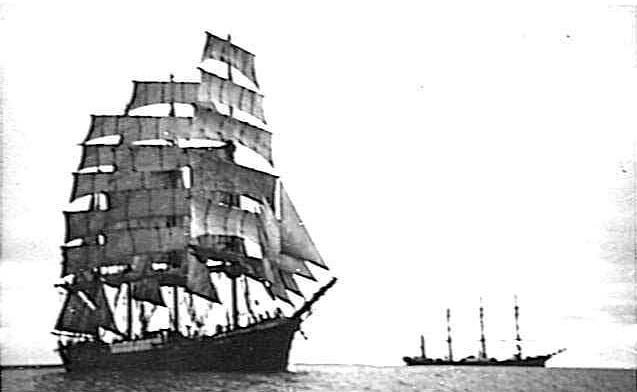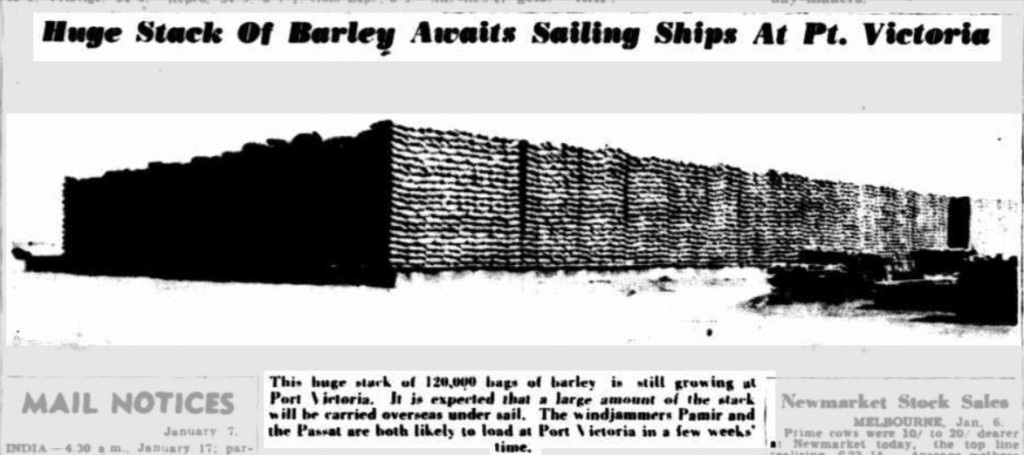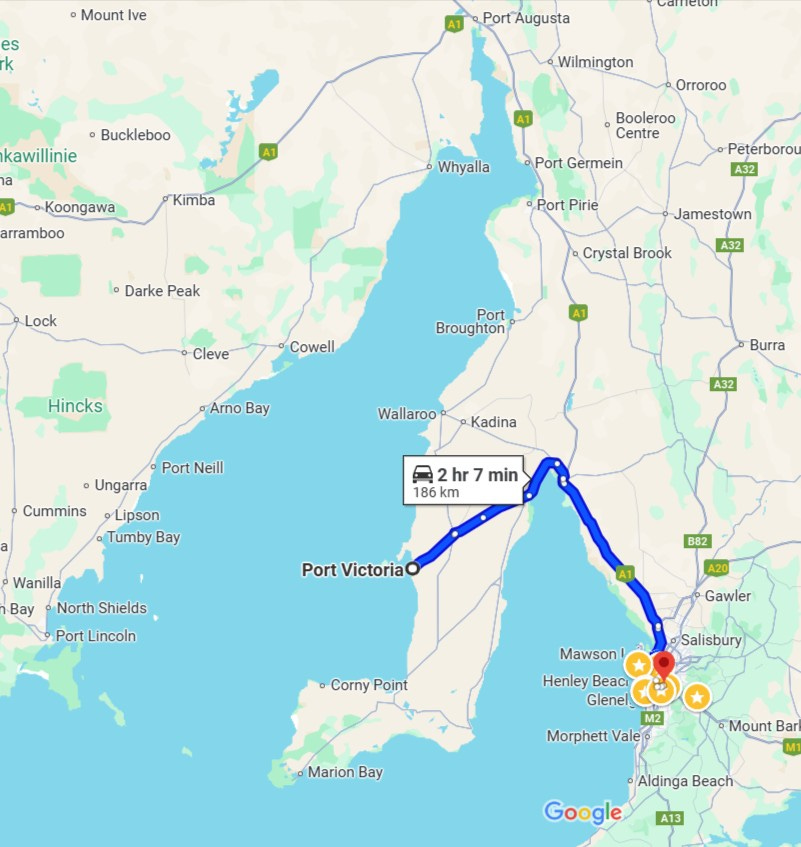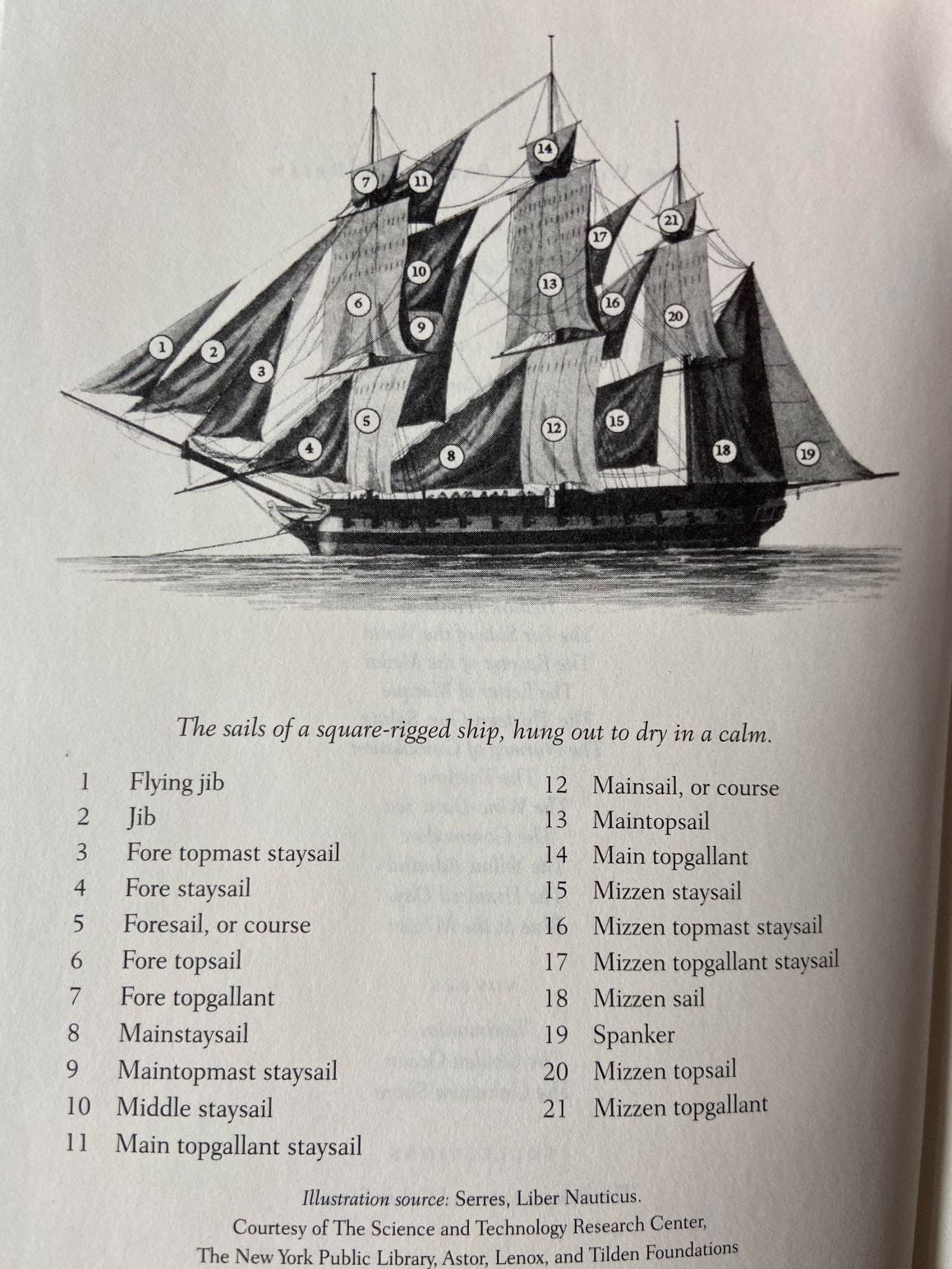In 1949 my father Rafe was taken on a long drive by his grandfather Constantine Trent Champion de Crespigny (1882-1952)* from Adelaide to Port Victoria on Spencer Gulf. Their trip was to look at two sailing ships, the Pamir and the Passat, which were moored there loading bagged grain.
Rafe remembers the day very clearly. A dolphin swam alongside when he and his grandfather took the tender out to the ship. There was a photograph of himself on the deck, but it is now lost. He also recalls souveniring some grain off the deck of the ship and growing it at home.
They had afternoon tea in the captain’s cabin [Rafe can’t remember of which ship, but thinks it was the Pamir]. He [the captain] was hospitable, but was rather pressed into the afternoon tea because the captain from the other ship came across while they were there and was looking expectant!

The Pamir was a four-masted barque, launched in 1905. Her 1949 passage with a cargo of wheat made the Pamir the last windjammer to carry a commercial load around Cape Horn.
After the 1949 voyage both ships were sold and were eventually converted to freight-carrying school-ships for merchant marine trainees. On 21 September 1957, Pamir was caught in a hurricane and sank off the Azores.
The Passat, a German four-masted steel barque, was launched in 1911. (The name “Passat” is German for trade wind.) Passat was bought in 1959 by the Baltic Sea municipality of Lübeck and is now a venue for events, a youth hostel, and museum ship.

There were only three or four barges to load the grain and the process took several weeks.
The windjammers Passat and Pamir left Port Victoria in May 1949 loaded with grain for Europe. The voyages from South Australian wheat ports on the Yorke Peninsula to Europe received much media coverage. People would bet on which ship would make the fastest voyage of the year.
Advertiser (Adelaide, SA), Monday 30 May 1949, page 3
Pamir Sails; Passat Delayed
PORT VICTORIA May 29
The barque Pamir, with 60,200 bags of barley aboard, sailed at 9 a.m. on Saturday for the UK. She was out of sight by 1 p.m.
The Passat with 56,181 bags of wheat, has been delayed owing to two members of her crew, a Frenchman and an Englishman, not reporting for duty and another being in hospital. Seven applications have been received for the crew, including a St. Peters man who wishes to get to Birmingham to join the staff of a bank. The master of the Passat (Capt Hagerstrand) hopes that he will be able to sail early on Tuesday morning.Despite the Pamir‘s head start the Passat won the race.
Advertiser, Monday 3 October 1949, page 2
Passat Wins Last Of Grain Races
Australian Associated Press LONDON, Oct. 2.
The four-masted Finnish barque Passat, which anchored this afternoon at Barry Roads, South Wales won the grain race from Australia by some hours from her rival four-master, the Pamir.
As the Passat dropped anchor, the Pamir was still to seaward of Falmouth light house with about three miles to go. She had been becalmed for some time within sight of the Lizard light.
The two sailing ships left Port Victoria (SA) on May 28 on what is almost certain to be the last of the grain races.
The Ministry of Food intends to use both ships to store grain until their owner, Capt. Edgar Erikson decides on their future.
Capt. Erikson, who refuses to sell them for scrap, said recently, "I wish there was a place somewhere in a beautiful fjord where the last windjammers could retire to die."An article in the Adelaide News describes the voyage of the Pamir:
News (Adelaide, SA), Monday 31 October 1949, page 16
Pamir had hard trip
A graphic story of the last of the Australia England windjammer races between the Passat and the Pamir is told in a letter received by Capt H. V. Warner, of Second avenue, Rosslyn Park.
The letter, from Mrs. Ngaire May Smyth, wife of the second mate of the Pamir, who signed on as a stewardess at 1/ a month, tells of gales, high seas, snowstorms, and icebergs.
The race was won by Passat, which arrived in England 122 days out. The Pamir took 127 days.
Mrs. Smyth said the Pamir ran into severe mid-winter gales after clearing Tasmania. South of New Zealand a very heavy gale was experienced, and their ship was hove to under shortened sail.
"The portholes on the lee side were always under water, and many sails were torn," she said.
Halfway across the South Pacific, the Pamir ran into snow squalls, and icebergs were seen in the distance.
"We saw the sun very rarely, and the decks were constantly covered with snow," she said.
Forty-four days out from Australia the Pamir passed Cape Horn. Steady progress was made through the South Atlantic, and the Pamir crossed the Equator 70 days out.
"After that, luck was against us," she said. "We ran into a hurricane which swept seas over the decks and flooded the after accommoda tion."
After a week of running up to the Azores before a fresh trade wind, the ship was be calmed for several days.
"From the Azores we had not more than a few hours of good westerly winds all the way to England," she said.*My father remembers his grandfather as being very interested in boats and “well-versed in sails: when I [Rafe] was small he taught me all their names and positions – like the illustration at the front of the Patrick O’Brian books. … he also got me onto the Hornblower books very soon after they came out … I was told, just in passing, that he [Constantine Trent] had wanted to join the navy, but that there was some physical reason he could not do so – hard to imagine what it might have been; he always seemed very fit. [I, Anne, think it might have been his eyesight – he always has glasses in photographs.] It was said to be for that reason that he became a doctor, hoping to enter the service by that route. At some point, however, he took up civilian practice, and when the war came in 1914 he joined the army – the navy would surely have been more difficult at that time, and the army would be quite straightforward.”
This post was first published at https://anneyoungau.wordpress.com/2025/06/17/afternoon-tea-on-a-windjammer/ The original post includes some more photographs and newspaper articles




I did not realise that grain was still being transported from Australia to Europe in Windjammers in the 1940's! I have so much to learn. My maternal great great-grandparents (Hannah and Robert Evans) arrived at Port Adelaide from Wales on board the 'Morning Star" in 1863. He worked as a copper smelter at Wallaroo, however the family ended up in Lithgow
NSW at some point. I am still digging into that history.
Your father had a great memory Anne. I loved reading the newspaper reports. I must admit I had to to check your map for Port Victoria as I was not familiar with it.